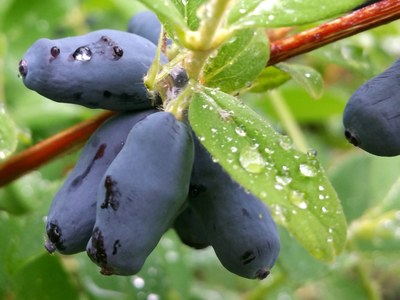In North Dakota Try Canadian Haskaps Instead of Blueberries
Blueberries are delicious—but they are almost impossible to grow in North Dakota.
We don’t have the proper soil to grow blueberries. Blueberries demand a very acidic soil (pH 4.5–5.5). This is rare in our state. Most of us have a prairie soil that is neutral to slightly alkaline (pH 7.0–8.5). Blueberries will starve in these soils.
Our winters are too harsh to grow blueberries. In the northern regions of our state (Zone 3), it is too cold to grow blueberries. The plants will freeze to death.
In the warmer regions (Zone 4), the plants can die unless they are blanketed with snow. Snow is unpredictable in our state, to say the least.
Although it is very tough to grow real blueberries here, we can grow other fruits that look and taste like blueberries.
Canadian haskaps (Lonicera caerula) are very easy to grow. These blue-fruited honeysuckles thrive in our prairie soils. Millions of haskaps are planted in the Canadian prairie provinces. The plants are hardy to –40°F. The spring-flowering shrubs grow up to 4 feet tall and require little care.

Haskaps are delicious. Their taste has been likened to a blueberry with essences of raspberry, black currant and/or blackberry. Its texture is like a blueberry. The skin is thin and the seeds are tiny and edible. The berries are eaten fresh, baked into pies, made into jams, or frozen and sprinkled onto ice cream.
Haskaps are harvested in late June/early July. You can expect two pounds of berries per bush after three years, and sometimes double that yield as the plant matures. Haskap cultivars from the University of Saskatchewan are recommended for their superior flavor. ‘Borealis’ has juicy fruits and is a great choice for gardeners. Sprinkle a few ‘Berry Blue’ or ‘Cinderella’ plants in the row for pollination.
Birds love haskaps, too. Be prepared to put netting over the shrubs when berries show blue color.
Forget about growing blueberries and stop challenging the powers of Mother Nature. Grow haskaps instead. Cooperate with Mother Nature and you will be successful. Go to University of Saskatchewan and NDSU Hardy Fruits Project websites for more information.
Written by Tom Kalb, Extension Horticulturist, North Dakota State University. The photo was made available under a Creative Commons license specified by the photographer: karen_hine. For questions on this webpage, please contact Tom Kalb.